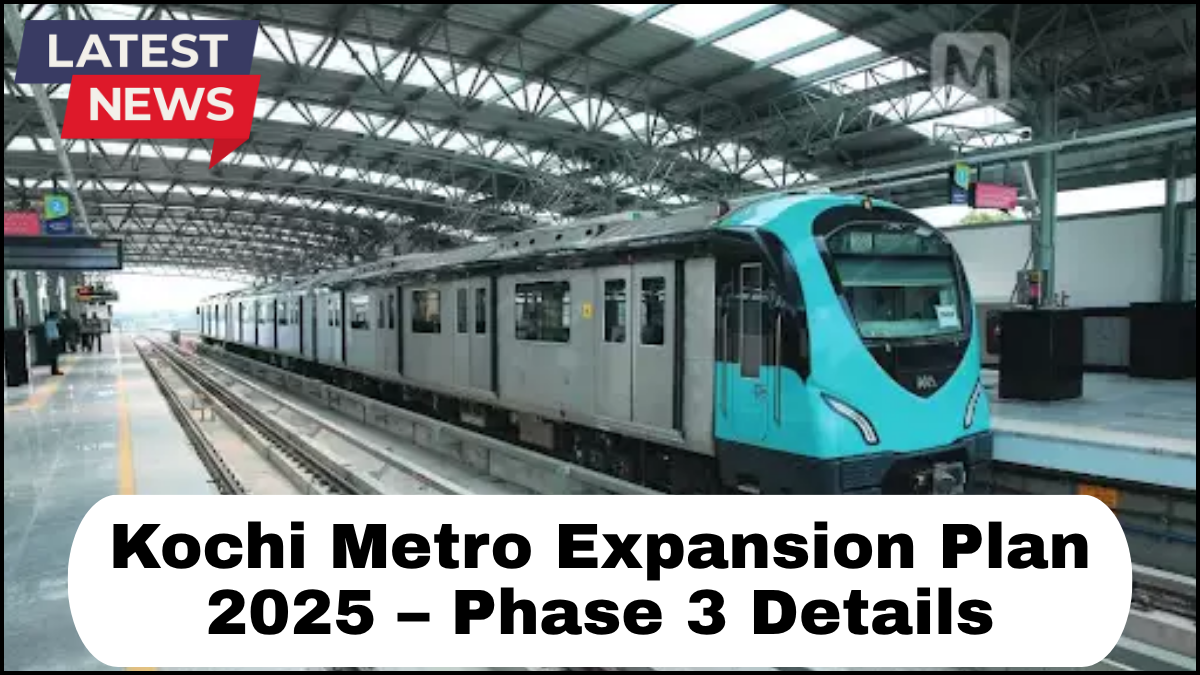The Kochi Metro Expansion Plan 2025 marks a critical milestone in Kerala’s ongoing commitment to smart mobility and sustainable urban development. Phase 3 of the expansion is not just about adding kilometers of track—it’s a calculated move to reshape the city’s transport grid, reduce congestion, and promote inclusive growth across the Greater Kochi region.

Here’s a comprehensive breakdown of what Phase 3 entails, why it matters, and how it’s poised to redefine urban connectivity in Kochi.
What Is Phase 3 of the Kochi Metro Expansion?
Phase 3 of the Kochi Metro Expansion Plan 2025 focuses on expanding the metro network further into key suburban zones and high-density residential and commercial hubs. The proposed stretch under this phase spans approximately 70 kilometers, making it the most ambitious stage so far in terms of scale and reach.
The expansion plan has been strategically crafted by the Kochi Metro Rail Limited (KMRL), in consultation with the Delhi Metro Rail Corporation (DMRC) and other urban planning bodies. The goal is to enhance multi-nodal connectivity and make public transport a preferred choice for daily commuters.
Proposed Routes in Phase 3
1. Infopark to Kakkanad Extension:
This highly anticipated 11.2 km corridor aims to connect the thriving IT hub of Infopark to the rest of the city. With increasing tech-sector employment and high footfall, this route is crucial for improving work-life balance and cutting commute times.
2. Aluva to Angamaly Line:
The Aluva-Angamaly corridor (around 23 km) is designed to serve the northern stretches, linking the metro with the Cochin International Airport. This airport connectivity has been a long-pending demand and is expected to significantly reduce road traffic and enhance ease of travel for both residents and tourists.
3. Tripunithura to S.N. Junction:
A shorter but important extension, this 3 km line will complete an earlier loop that increases access to the Tripunithura region—home to cultural heritage centers and emerging residential zones.
4. Smart Suburban Link:
A new proposal under Phase 3 includes an East-West connector line, bridging satellite towns like Thrikkakara and Kalamassery. These corridors will be vital for decentralizing city development and integrating Kochi’s outlying districts into the metro ecosystem.
Urban Development Impacts
The Kochi Metro Expansion Plan 2025 is not just a transit project—it’s a cornerstone of holistic urban development. The extension is expected to:
-
Reduce Road Congestion: With an expanded metro footprint, there will be a significant shift from private vehicles to public transit, easing bottlenecks on major roads like NH-66 and Seaport-Airport Road.
-
Encourage Transit-Oriented Development (TOD): Phase 3 will stimulate mixed-use real estate projects along metro lines, fostering vibrant, walkable communities near stations.
-
Support Green Growth: The metro system continues to focus on energy efficiency, solar-powered stations, and eco-conscious infrastructure.
-
Boost Employment: The construction and eventual operation phases will generate thousands of jobs, both directly and indirectly, in sectors like construction, retail, and maintenance.
Timeline and Budget
The estimated cost for Phase 3 is pegged at ₹12,000–₹14,000 crore, with funding expected to come from a mix of state support, multilateral agencies, and public-private partnerships. The project is expected to be rolled out in stages, with preparatory groundwork starting in early 2025 and major segments aiming for completion by 2029.
Integration with Other Transport Modes
One of the highlights of this phase is the integration with Kochi Water Metro and city buses. Unified ticketing systems and feeder services are in the pipeline to ensure smooth first-mile and last-mile connectivity. This seamless transit experience is aimed at making Kochi a national model for multimodal urban transport.
Comparison With Other Metro Expansions
Unlike many Tier-2 cities where metro extensions are confined to small additions, Kochi’s Phase 3 reflects a forward-thinking vision. The density of stations, multimodal integration, and focus on equitable urban growth set it apart. It mirrors successful models in European cities while addressing uniquely local needs.
FAQs – Kochi Metro Expansion Plan 2025
Q1. What is the total length of the Kochi Metro Phase 3 expansion?
The planned expansion under Phase 3 covers approximately 70 kilometers, including major extensions to airport and IT corridors.
Q2. Will Phase 3 include airport connectivity?
Yes. The Aluva to Angamaly stretch includes a link to Cochin International Airport, which is expected to enhance convenience for travelers and reduce road traffic.
Q3. When will Phase 3 construction begin?
Groundwork is expected to start in early 2025, following the final approval of Detailed Project Reports (DPRs).
Q4. How does this expansion support urban development?
The expansion aligns with transit-oriented development principles, encouraging high-density, mixed-use development near metro stations and reducing the city’s carbon footprint.
Q5. Is there any focus on green infrastructure?
Absolutely. Kochi Metro has committed to using solar energy, rainwater harvesting, and eco-friendly materials in its expansion, maintaining its reputation as one of India’s greenest metros.
click here to learn more
